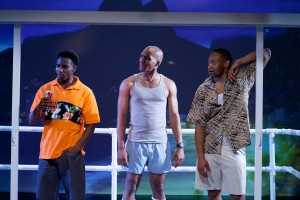In hopes to bring humanity to the story of the male consumers of prostitution, Nikkole Salter’s play Carnaval focuses on thee African-American men who travel to Rio, Brazil to honor the death of their friend. Once in Brazil, Demetrius (Bjorn DuPaty), Jalani (W. Tre’ Davis), and Raheem Monroe (Gabriel Lawrence) are immediately faced with the temptation of prostitution. However, this trip goes downhill when one person in the group disregards the “rules” of Rio and lands them all in trouble.
This coming of age story with a twist combines the need to escape the stereotypes and obligations an African-American man has to his brotherhood with the undeniably timeless lesson that one’s actions do have consequences — all with the backdrop of Brazil’s sexual tourism.
While there are some big gaps in the story line (such as the development of the dead friend, Jared, and the reason for his death), the actors' flawless execution made the audience forget that there are only three men on the stage. They successfully streamline the passing of time and convince the audience that what we see is a valid timeline of what has happened on their trip to Rio.
The camcorder projections by Emre Emirgil contain only images of scenery and short clips of the men. These images complimented the world of the play by reminding the audience that this play focuses only on the bodies of these men and excludes any images of the women that are in their lives or the women that these men cross paths with in Rio. This forces the audience to only imagine women through the eyes of the men. For example, the audience is only able to imagine the female prostitutes as “Full lips. Tiny waist… white girl hair. Spanish girl skin. Black girl booty. And southern girl attitude” courtesy of Jalani’s description given on the first day the three men arrive in Brazil.
According to the playwright in the traditional discussion after every show, the play purposefully excluded women from acting in the show or using the images of female bodies in the projections in order to limit the exploitation of women within her show. Instead, we are forced to make connections with the male consumers on stage. Throughout the show, these three characters' authentic personalities make you laugh at the cultural references they use, as well as draw you in emotionally with the sob stories they share with each other. These characters are three-dimensional and fit into the 1990's time period.
By the end of the play, there is no resolution or grievance towards the prostitutes and women they exploit on a daily basis. Instead, many audience members can be left with a dread in their heart and hopeless feeling that people don’t realize the mistakes they made or what the mistake even was.
However, to help ease the pain of the soul, dramaturges Ebony Noelle Golden and Sade Lythcott create a display in the lobby of the theater which offers the historical explanation of why people within our society are so detached and nonreactive to the sexualization and objectification of Black women’s bodies in the media and within our lives. Without this display, there would be an almost unsatisfying feeling to the play.
Overall, the play successfully takes a first step at bringing awareness to sexual tourism and sheds light on how the African American community are affected by international matters. It provides sufficient insight into understanding the demand side in the “demand and supply” of sexual tourism in countries such as Brazil.
Carnaval ran until Nov. 16 at the National Black Theatre in Harlem (2031 5th Avenue between 125th and 126th Sts.). For more information, visit www.nationalblacktheatre.org.



